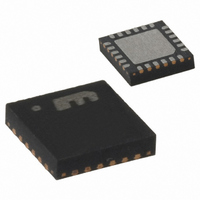MIC22602YML TR Micrel Inc, MIC22602YML TR Datasheet - Page 12

MIC22602YML TR
Manufacturer Part Number
MIC22602YML TR
Description
ID BUCK SYNC ADJ 6A 24MLF
Manufacturer
Micrel Inc
Type
Step-Down (Buck), PWM - Voltage Moder
Datasheet
1.MIC22602YML_TR.pdf
(24 pages)
Specifications of MIC22602YML TR
Internal Switch(s)
Yes
Synchronous Rectifier
Yes
Number Of Outputs
1
Voltage - Output
Adj to 0.7V
Current - Output
6A
Frequency - Switching
1MHz
Voltage - Input
2.6 ~ 5.5 V
Operating Temperature
-40°C ~ 125°C
Mounting Type
Surface Mount
Package / Case
24-MLF®, QFN
Voltage - Supply
2.6 V ~ 5.5 V
Frequency-max
1.2MHz
Duty Cycle
100%
Pwm Type
Voltage Mode
Buck
Yes
Boost
No
Flyback
No
Inverting
No
Doubler
No
Divider
No
Cuk
No
Isolated
No
Lead Free Status / RoHS Status
Lead free / RoHS Compliant
Other names
576-3645-2
MIC22602YML TR
MIC22602YMLTR
MIC22602YML TR
MIC22602YMLTR
Figure 2 shows an efficiency curve. The portion, from 0A
to 1A, efficiency losses are dominated by quiescent
current losses, gate drive and transition losses. In this
case, lower supply voltages yield greater efficiency in
that they require less current to drive the MOSFETs and
have reduced input power consumption.
The region, 1A to 6A, efficiency loss is dominated by
MOSFET RDS
supply voltages will increase the Gate-to-Source voltage
on the internal MOSFETs, reducing the internal RDS
This improves efficiency by decreasing conduction loss
in the device but the inductor loss is inherent to the
converter. In which case, inductor selection becomes
increasingly critical in efficiency calculations. As the
inductors are reduced in size, the DC resistance (DCR)
can become quite significant. The DCR losses can be
calculated as follows;
From that, the loss in efficiency due to inductor
resistance can be calculated as follows:
Efficiency loss due to DCR is minimal at light loads and
gains significance as the load is increased. Inductor
selection becomes a trade-off between efficiency and
size in this case.
Alternatively, under lighter loads, the ripple current
becomes a significant factor. When light load efficiencies
become more critical, a larger inductor value maybe
desired. Larger inductance reduces the peak-to-peak
inductor ripple current, which minimize losses. The
following graph in Figure 3 illustrates the effects of
inductance value at light load.
Micrel, Inc.
October 2009
Efficiency Loss =
L
PD
= I
OUT
(ON)
100
Figure 2. Efficiency Curve
95
90
85
80
75
70
65
60
55
50
50
0
2
and inductor DC losses. Higher input
× DCR
⎡
⎢
⎢
⎣
1
1
LOAD CURRENT (A)
−
⎛
⎜
⎜
⎝
Efficiency
2
(
V
OUT
3
V
OUT
⋅
V
V
I
4
IN
OUT
OUT
= 3.3V
⋅
I
= 1.8V
OUT
5
)
+
L
6
PD
⎞
⎟
⎟
⎠
⎤
⎥
⎥
⎦
×
100
(ON)
.
12
Compensation
The MIC22602 has a combination of internal and
external stability compensation to simplify the circuit for
small size, high efficiency designs. In such designs,
voltage mode conversion is often the optimum solution.
Voltage mode is achieved by creating an internal 1MHz
ramp signal and using the output of the error amplifier to
modulate the pulse width of the switch node, thereby
maintaining output voltage regulation. With a typical gain
bandwidth of 100-200kHz, the MIC22602 is capable of
extremely fast transient responses.
The MIC22602 is designed to be stable with a typical
application using a 1µH inductor and a 100µF ceramic
(X5R) output capacitor. These values can be varied
dependant upon the tradeoff between size, cost and
efficiency,
(
stability can be achieved. The minimum recommended
inductor value is 0.47µH and minimum recommended
output capacitor value is 22µF. With a larger inductor,
there is a reduced peak-to-peak current which yields a
greater efficiency at lighter loads. A larger output
capacitor will improve transient response by providing a
larger hold up reservoir of energy to the output.
The integration of one pole-zero pair within the control
loop greatly simplifies compensation. The optimum
values for C
below.
2
×
L
* VOUT > 1.2V,
π
×
0.47µH
1
2.2µH
1µH
L ⋅
Figure 3. Efficiency vs. Inductance
COMP
C
keeping
C
) ideally less than 26kHz to ensure
95
90
85
80
75
70
65
60
55
50
†
(in series with a 20k resistor) are shown
0
VOUT > 1V
22-47µF
15-33pF
0*-10pF
0
OUTPUT CURRENT (mA)
†
-15pF
L = 4.7µH
200
vs. Inductance
the
Efficiency
L = 1µH
400
LC
15-22pF
33-47pF
100µF
47µF-
22pF
600
natural
M9999-102809-A
800
100-220pF
100µF-
470µF
33pF
33pF
MIC22602
frequency











